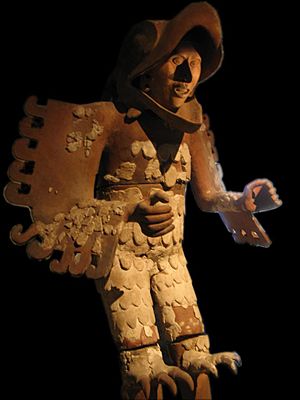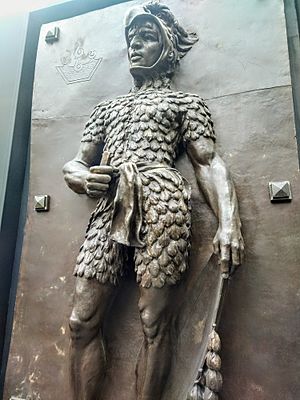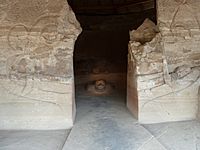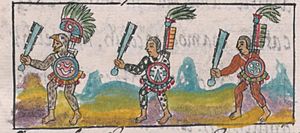Eagle warrior facts for kids

Eagle warriors were a special group of soldiers in the Aztec army. They were one of the two main elite military groups in Aztec society, the other being the Jaguar warriors. These warriors were called cuāuhocēlōtl in the Classical Nahuatl language.
The word cuāuhocēlōtl combines cuāuhtli (eagle warrior) and ocēlōtl (jaguar warrior). These special military groups were made up of the bravest soldiers. They were also chosen if they had captured many prisoners in battle. Of all the Aztec warriors, the eagle warriors were the most respected.
Unlike some other warrior groups, common people could also become eagle warriors. This happened if they showed great bravery and skill. The life of an Aztec warrior involved constant fighting. A main goal of this fighting was to capture prisoners. These prisoners were then offered to their gods. As the Aztec Empire grew, expanding its power also became very important.
Today, the eagle warrior is a strong symbol of Aztec culture. It also represents Mexican traditions. Some companies use the eagle warrior as a symbol. It shows strength, competition, and a link to ancient Mexican cultures. For example, AeroMexico's logo features a cuāuhtli.
Contents
Aztec Society and Life
Aztec society had different social groups. These included kings, nobles, generals, priests, farmers, and slaves. Politically, society was built around independent city-states called altepetl. Each altepetl had smaller parts called calpulli. These were usually made of several family groups.
Aztec society was very organized and had many levels. There was a clear difference between nobles and common people. Both groups had their own rules for social status and responsibilities. For example, commoners did not have the same rights to land or clothing as nobles. The economy mainly depended on farming and warfare. Trade, both near and far, was also very important.
Becoming an Eagle Warrior
All Aztec boys learned about weapons and fighting. This was part of their basic education. Until age fourteen, parents taught their children. However, local authorities from their calpulli supervised this learning. Boys regularly visited temples to show their progress.
Only the best students could become eagle warriors. This was because eagle warriors were seen as part of the nobility. At age 17, young Aztec men became warriors. They then began formal military training. Recruits had to be brave and honorable. Boys from noble families also learned about religion, politics, or history from priests. To become an adult, a young man had to capture his first prisoner.
Aztec warriors could move up in rank by capturing enemies. To join the elite warriors, they had to capture at least four prisoners. After performing 20 or more brave deeds, such as capturing foes, they could become a jaguar or eagle warrior.
Warrior Gear and Weapons
Aztec warriors used several weapons. These included a atlatl (a spear-thrower), spears, and daggers. Their blades, called macuahuitl, were made by putting sharp obsidian stones into wood. They also threw Firestones at enemies using slings made of wool. Most Aztec weapons were designed to stun and capture opponents. They were not mainly for killing them.
The uniforms of eagle warriors showed their bravery and strength. They wore a light, close-fitting breastplate. This was good for the warm Mesoamerican climate. Their shields were colorful and decorated with feathers. Warriors also covered their legs with leather strips, like early shin guards. For headgear, eagle warriors wore eagle heads with open beaks. They also used eagle feathers as decorations.
Successful eagle warriors were rewarded. They were allowed to wear fancy jewelry and materials. The quality of their jewelry also depended on their rank. They wore expensive things like red ocher. Their headdresses were made of beautiful quetzal feathers. The highest-ranking warriors received special items from the ruler himself. These included a green stone lip plug called chalchiuhtentetl. They also got leather earplugs called cuetlaxnacochtli.
Their slings were likely made from maguey plant fibers. This was a strong material from plants like henequen.
Eagle Warriors in Society

The idea of eagle and jaguar warriors comes from a story about two gods. These gods, Nanahuatzin and Tecuciztecatl, sacrificed themselves to bring life to the sun. They came out of the fire as an eagle and a jaguar. This belief made the eagle warrior's place in society very important. Their clothing also showed this. Eagles were seen as soldiers of the Sun, because the eagle was a symbol of the Sun. Eagle warriors dressed like eagles, using eagle feathers and wearing eagle headgear. They were among the highest-ranking warriors in Aztec society.
Sacrifice was very important in Aztec society. They believed it was their duty to feed the sun with human blood. The warriors provided the captives needed for these offerings. This links back to the origin of the Eagle Warriors and their connection to the gods.
Eagle and jaguar warriors were two of the only warrior types who were full-time professionals. Because of their excellent training, they were leaders and commanders. They led both in battle and in daily life. When they reached this rank, they were equal to nobles. The warrior's path was a way to improve one's social status. It gave them many of the same benefits as nobles. A graduate warrior could drink pulque (an alcoholic drink). They could also have many partners and eat at the royal palace.
In their city, they became full-time warriors. They worked for the city-state to protect merchants. They also helped keep order in the city. So, they were like the civil or police force of Aztec society. These warrior groups helped the Aztecs defeat the Spanish during La Noche Triste.
Eagle Warrior Temple

The Eagle Warrior Temple is found in Malinalco, Mexico. The temple sits on a hill. It is completely carved out of the rock. The temple is round. Its entrance has 13 steps and two jaguar sculptures. The entrance itself was carved to look like the open mouth of an Aztec earth monster. The temple was next to the ruler's palace. It served as a base for the Eagle Warriors. It was also a place to plan battle strategies.
Inside the temple, there is a long bench that covers half of the inner room. This bench has carved sculptures of eagles and a jaguar. In the center of the room, a giant eagle is carved into the floor. Some believe this central eagle was used as an altar or a throne. The buildings around the temple had murals. These paintings showed scenes from a warrior's life. There were also murals of dancing eagles and jaguars in other structures in Malinalco.
See also
 In Spanish: Guerrero águila para niños
In Spanish: Guerrero águila para niños


